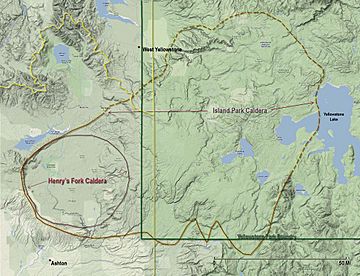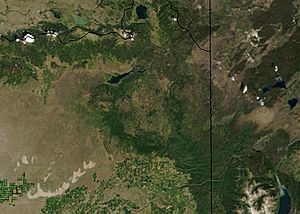Henry's Fork Caldera facts for kids
Quick facts for kids Henry's Fork Caldera |
|
|---|---|

Diagram of Henry's Fork and Island Park Caldera
|
|
| Highest point | |
| Elevation | 2,805 m (9,203 ft) |
| Geography | |
| Location | Fremont County, Idaho, United States |
| Geology | |
| Mountain type | Caldera |
| Last eruption | 1.3 myr |

The Henry's Fork Caldera is a huge, bowl-shaped dip in the ground in eastern Idaho. It's part of a beautiful area called Island Park, which is just west of Yellowstone National Park. This giant bowl was created by a massive volcanic eruption about 1.3 million years ago. This eruption came from the Yellowstone hotspot, which is a super-hot spot deep inside the Earth.
Contents
What is the Henry's Fork Caldera?
A caldera is like a giant crater. It forms when a volcano erupts with so much force that its top collapses inwards. The Henry's Fork Caldera is a perfect example of this. It was formed by one of the biggest eruptions in Earth's history.
A Giant's Footprint: How it Formed
About 1.3 million years ago, the Yellowstone hotspot caused a huge explosion. This eruption sent out a massive amount of ash and rock, about 280 cubic kilometers! That's enough material to fill many, many football stadiums. After all that material was blasted out, the ground above the empty magma chamber collapsed. This created the large, round depression we now call the Henry's Fork Caldera. The ash from this eruption is known as the Mesa Falls Tuff.
Nested Calderas: Henry's Fork and Island Park
The Henry's Fork Caldera is special because it sits inside an even bigger caldera. This larger one is called the Island Park Caldera. Imagine a smaller bowl placed inside a much larger one. The Island Park Caldera is much older and shaped more like an oval. It even stretches into Yellowstone National Park.
Even though the Henry's Fork Caldera is smaller than Island Park, it's still huge! It measures about 18 miles long and 23 miles wide. You can easily see its curved edges from many spots in the Island Park area. Many calderas have formed from the Yellowstone hotspot over millions of years, including the famous Yellowstone Caldera. But the Henry's Fork Caldera is the only one that is still clearly visible today. It's one of several supervolcanoes that helped shape the Snake River Plain.
A River Runs Through It
The Henrys Fork river flows right through the middle of the Henry's Fork Caldera. As the river leaves the caldera, it creates two beautiful waterfalls: Upper and Lower Mesa Falls.
The caldera is surrounded by natural landmarks. On the south, there's Ashton Hill. To the west, you'll find Big Bend Ridge and Bishop Mountain. Thurmon Ridge is to the north, and Black Mountain and the Madison Plateau are to the east.
Fun Things to Do in the Caldera Area
The Henry's Fork Caldera is located in the beautiful Island Park area. This region is famous for its thick forests, clear streams, and many lakes and ponds. It's a great place to see wildlife. You can also enjoy fishing in the clear waters.
Harriman State Park is a popular spot located right inside the caldera. From here, you can often see the tall, jagged peaks of the Teton Range in nearby Wyoming.
Many people visit the area for outdoor activities. In winter, snowmobiling and Nordic skiing are very popular. In warmer months, fishing and wildlife viewing are favorite pastimes. It's a perfect place for nature lovers and adventurers!

